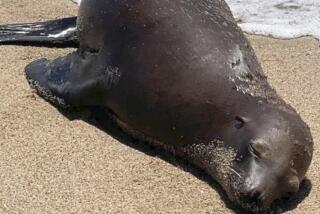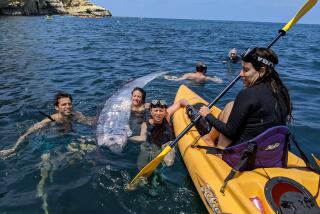Whale seen as victim of ship
The blue whale found dead last week in the Santa Barbara Channel was probably the third victim of a ship collision in two weeks, scientists said Saturday as they conducted a post-mortem on the 60-ton creature.
As surf roiled around the massive carcass on a beach at Point Mugu, biologists cut doorway-size openings in its belly and probed its organs for tissue specimens. About an hour after they had peeled back 4-inch-thick sheets of snowy blubber, they started removing foot-long bone fragments that had chipped away from the animal’s 9-foot ribs. Later, they found other fractured bones, including a smashed cranium.
“It’s definitely a ship strike,” said Easter Moorman, a spokeswoman for the Santa Barbara Museum of Natural History, which was directing the necropsy of the not-quite fully grown male. “The animal died instantly.”
Three blue whales -- members of the largest species on Earth -- have been discovered dead off Southern California in the last two weeks, the most recent on Wednesday. Two found in the Santa Barbara Channel were thoroughly examined by scientists, who concluded that they were hit by ships. One found in Long Beach Harbor was towed out to sea, but a biologist who viewed it said it probably had been hauled into port on a ship’s bow.
A blue whale washed up in Ensenada, but scientists are divided as to whether it might have been the one originally seen in Long Beach.
The questions looming around this puzzling and highly unusual succession of deaths await extensive laboratory testing of the samples extracted Saturday. The tests, which may take months, could point to an illness or infection that slowed the whales as they swam through the busy shipping lanes off Southern California. Tissues from the other whales were too deteriorated for analysis.
Scientists who worked on Saturday’s necropsy said that, pending test results, their working theory is that the whale had been poisoned by domoic acid. Produced by certain marine algae, domoic acid is known to have killed sea lions and dolphins in the region.
Still open is the question of whether Navy sonar exercises off San Diego may have played a role. On Aug. 31, a ban on the exercises was at least temporarily lifted by a federal judge, who ruled that environmental objections did not outweigh the nation’s security needs. The training resumed off San Clemente Island on Sept. 11.
The Natural Resources Defense Council, one of the groups seeking to block the sonar training, has not drawn any conclusions.
“These deaths are unusual, but it’s premature to say what’s causing them,” said Michael Jasny, an NRDC policy analyst who has been active on the sonar issue.
Michelle Berman, a biologist with the Santa Barbara Museum of Natural History, said sonar was not a likely culprit, contending that there were significant physiological and behavioral differences between blue whales off California and beaked whales in the Bahamas, where sonar has been linked to a mass die-off.
The whale at Point Mugu was hauled there by a semi-inflatable towboat from the Santa Barbara Channel, a 22-mile journey that took a little more than 12 hours. When the whale beached about 6:30 a.m. Saturday, the boat was attacked in the surf by a 15-foot great white shark, according to its owner, Paul Amaral, of Channel Watch Marine.
“I saw the head of a shark on one side and his tail on the other,” Amaral said. “He’d flattened one of my tubes with his teeth before we cut the tow line and I bugged out of there.”
The whale’s innards were buried on the beach. Its carcass was to be towed about five miles out to sea Saturday evening.
More to Read
Sign up for Essential California
The most important California stories and recommendations in your inbox every morning.
You may occasionally receive promotional content from the Los Angeles Times.











